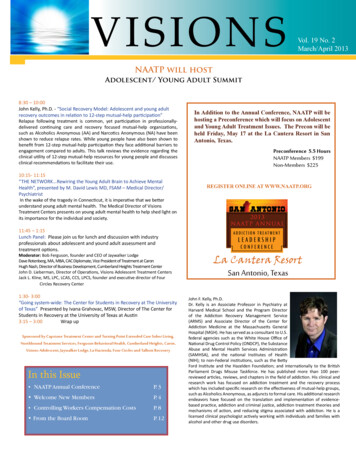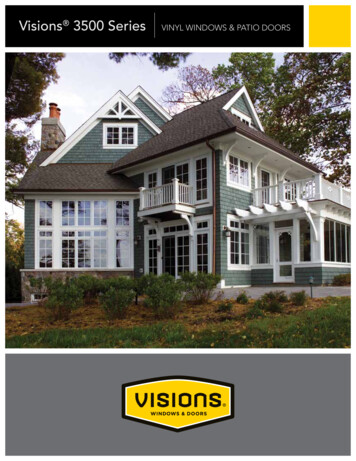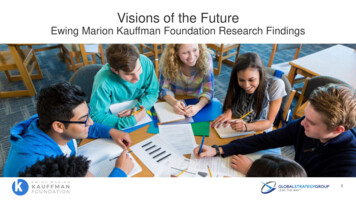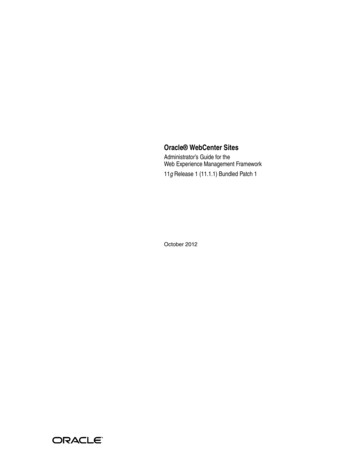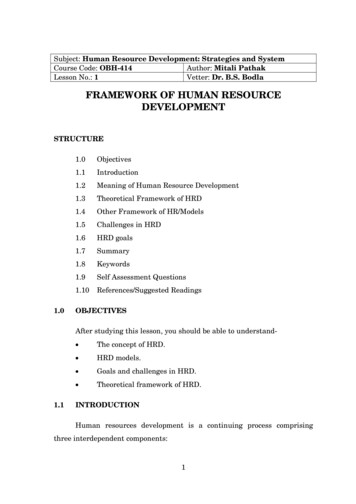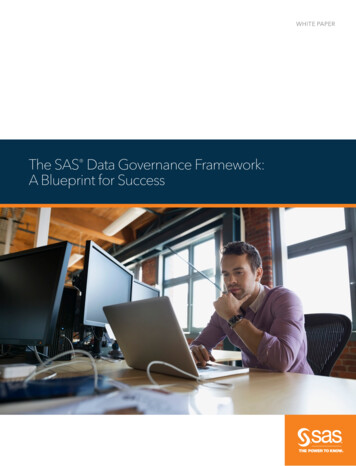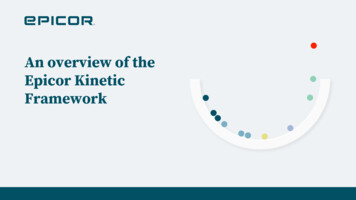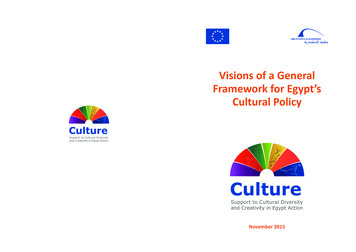
Transcription
Visions of a General Frameworkfor Egypt’s Cultural PolicyNovember 20151
2
Table of ContentDr. Ismail Serageldin’s Introduction5Introduction: Support to Cultural Diversity andCreativity in Egypt71- Preliminary OverviewEgypt in five cultural circlesOur Arab Culture and the Culture of KnowledgeAbout the Egyptian IdentityCountering the Current Conditions29313337382- The Current Cultural State of AffairsThe Egyptian Cultural SocietyKey cultural issues pertaining to the book,the song, the cinema, and the theater4144463- Cultural Reform in EgyptVision and ObjectiveSpecific ObjectivesAbout Education and MediaThe Creative Industries57575761644- Institutions and Mechanisms- Museums- Libraries and the Family Libraries- Ministry of Antiquities- General Authority for Cultural Palaces- General Egyptian Book Authority- The High Council of Culture- Arts Academy- Visual Arts Sector- Theater Section- Folklor and Performance Arts Sector67686971727475757779803
-The OperaFilm IndustryThe National Center for Traditional CraftsScientific SocietiesOral HeritageCultural Fields and reforming their positionsDar al Kuttub and National ArchivesThe National Translation Center5- FundingThe Cultural Development FundAntiquities FundThe Private and Public SectorsUsing Government Guarantee808184858686878789909091916- The Digital Revolution and How to Deal with ItThe New Knowledge Revolution (The Seven Pillars)First: Parsing, Life, and OrganizationSecond: Image and TextThird: Humans and MachinesFourth: Complexity and ChaosFifth: Computation and ResearchSixth: Convergence and TransformationSeventh: Pluridisciplinarity and Policy- A National Committee for DigitallyDocumenting Heritage- A National Digital Repository- A Fund for Digital Works- The Importance of Digital Publishing- On Intellectual Property in the Digital World7- On Implementation and Follow-Up4939394959595969697979899100103
Support to Cultural Diversity and Creativity in EgyptTwo years of tireless work throughout Egypt, from Alexandria toAswan, were required to implement the Support to Cultural Diversity andCreativity in Egypt project—a project supported by the European Union.The Bibliotheca Alexandrina youth have journeyed throughout Egyptto rediscover the country with a new approach by exploring Egypt’s villages,towns, and cities. As a result of the collaborative efforts of numerousministries to support the BA, such as the Ministries of InternationalCooperation, Culture, Higher Education, Antiquities, Education, and ForeignAffairs, in addition to the participation of over a thousand official and civilsociety organizations and creative individuals, the report in hand has beencreated following discussions, workshops, and activities to formulate acultural vision for Egypt; a vision that bolsters nationalism, motivatescultural work, and provides creators with the freedom to innovate for thefuture.This report has posed questions concerning the current state of affairs,the methods of addressing shortcomings, and future ambitions. Thesequestions will certainly create a widespread debate to preserve the aspiredvision, framed by those who contributed to the report, so that the Egyptiannational culture can become the promising prospect that we all anticipate.The culture of work, tolerance, and limitless creativity leads to social peaceand a comprehension of the youth’s energy. So, let us dream of the future.Here, at the BA, we will try our best to accomplish as many of the aspiredgoals as we can, and we will strive to present this report to the designatedauthorities, legislative councils, and decision makers. This is what we canpromise. However, we can only grow if we all work together; withoutpartnerships, we will not be able to move forward on the path toward thefuture. This is the form of collaboration we sought through this project.Dr. Ismail SerageldinDirector of the BA5
6
IntroductionSupport to Cultural Diversity and Creativity in Egypt“Support to Cultural Diversity and Creativity in Egypt” is a 24months project, co-funded by the EU, that has been implemented by theBibliotheca Alexandrina (BA) in different governorates in Egypt followingthe UNESCO 2005 Convention on the protection and promotion of thediversity of cultural expressions.The global objective of this action is to provide increased access toculture, to contribute to social cohesion, to protect and promote the diversityof cultural expressions and to improve the environment for creative andcultural production in order to have an impact on sustainable socioeconomic development.The Action started on 25 November 2013 through a set of diverseactivities grouped under the 3 following pillars: Pillar 1: A dialogue process for a National Cultural Strategy/Policyin Egypt Pillar 2: Interventions to support Egyptian cultural industries andalready existing Egyptian talents and cultural operators Pillar 3: Actions to support youth and new talents and increaseaccess to culture.The activities implemented under this action targeted EgyptianPopulation counting Egyptian artists, cultural operators, cultural industries,cultural institutions and officials and NGOs with a special attention to youth,children, women and disabled. The activities contributed to creating a futurepolicy for Egyptian culture, identifying and profiling cultural actors in thecountry, nurturing existing talents and artists as well as emerging artists,boosting the activities of cultural centers and institutions. The activities alsosupported capacity building and the restructuring of the cultural and creativesectors.7
The Action built upon the experience and knowledge of the BA andreinforced its role as an independent institution supporting national efforts inthe field of culture. Basing its vision upon three main pillars and through avariety of activities prepared for the Action, the BA seeks to use the richcultural heritage of Egypt and human capital to benefit from arts and cultureas a strong support element to the development of the country, and topromote artistic and cultural education.In line with the overall and specific objectives of the action, its mainoutputs and results, specific activities were designed to impact aconsiderable number of Egyptians working in the field of culture and onnormal Egyptians who did not have the chance to be exposed to culturalmanifestations in their life or need to be encouraged and engaged further.The activities were designed in a way to be self-sustained, to have acontinuous effect on the Egyptian cultural sector, and pave the way toencourage creativity and promote diversity.Based on the BA's experience in implementing a variety of activities,programs and research, the activities were regrouped in the following 3 mainpillars.Pillar “1”: A Dialogue Process for a Cultural Policy in Egypt-TheOrganization of Conferences, Seminars and Workshops.This pillar mainly focused on initiating a national dialogue in thecountry to lead to the formulation of a cultural strategy for Egypt. Thisnational dialogue was coordinated by the BA involving public and privatecultural institutions and individual experts. The BA acted as hub providingits facilities, organizational capacities, expertise and access to culturalstakeholders and coordinated between them to issue cultural policy papersand recommendations to be launched in the final conference. The activitiesof this pillar are as follows:8
1.1. Cultural Debates: Vision for an Egyptian Cultural PolicyThe BA created think-tanks of young and senior intellectuals, culturaloperators, artists, ministries and public authorities amongst others, to assessthe current cultural situation and the main actors in the country and thechallenges to be addressed. The members of the think-tanks engaged in astructured dialogue to draft a National Cultural Policy to be presented to theconcerned Egyptian authorities for discussion and adoption. In addition,some eminent experts produced researches defining the elements,constraints, challenges of the cultural reality in Egypt.For achieving the desired outputs the following took place: Forming and engaging members of the think-tanks through twelveperiodical working meetings to discuss and draft the culturalpolicy. Setting up a small secretariat office at the BA to coordinate andsupport the work of the think-tanks. Organizing four workshops where experts, policy makers wereinvited for debates and brainstorming. Compiling the research and statistics conducted by members of thethink-tanks and merging the findings of pillar 2 (MappingExercise) and Pillar 3 (Arts in the Classroom) to produce a draftNational Cultural Policy. Organizing a final workshop for final review and discussion of theproduced draft cultural policy. Printing of the final document that will be presented to policymakers and distributing it during the final conference.The meetings were attended by representatives from differentMinistries, such as the Ministry of Culture, Ministry of InternationalCooperation, Ministry of Antiquities, Ministry of Foreign affairs, Ministryof Education and Ministry of Higher Education. Different Universities werealso represented such as the Univeristies of Ain Shams, Cairo, Assiut,Mansoura, New Valley, Alexandria, Portsaid, Ismailia, Beni Suef, Sohagand Aswan amongst others .9
Also, eminent experts, senior and junior intellectuals, artists, novelistsand journalists from different cultural backgrounds and specializationsrepresented various institutions in the debates, such as the UNESCO Cairooffice, Almawred Althaqafy, l’Atelier d’Alexandrie, the Union for EgyptianWriters, Egypt's Writers Syndicate, the Egyptian Journalists' Syndicate, AlAhram Newspaper, Alyoum Alsabea Newspaper, Almasry AlyoumNewspaper, the General Egyptian Books Organization (GEBO), the NationalTelevision, Alhoreya Center for Innovation and some Palaces of Cultures,Egypt Public Libraries and many Civil Society Organizations (CSOs) amongothers.1.2. Conference on the “Policy Framework for Culture in Egypt”In order to disseminate the results obtained at the Action in generaland the Cultural Debates in particular, the final conference will be held togather a large and diversified number of participants. The conference willhighlight and showcase the following: The work of the think-tanks: this will include all produced documentsas well as the final version of the draft national cultural policy. The Directory and Portal of Pillar 2. Exhibitions capturing the work done in the activities of Pillar 3. A fair for the providers of cultural industries where they will displaytheir activities and products. A documentary about the whole action.This conference will be the main visibility public event showcasingthe efforts and results of the whole action and drawing attention to thecontinuation to the follow up work to be done in support of the activities thatwere completed.Pillar “2”: Interventions to Identify and Support EgyptianCultural Operators and IndustriesThis pillar seeks to identify and consolidate the existing culturalindustries and operators and provide them with the requested tools to boosttheir activities. The activities are designed and implemented in a way to10
upgrade their capacities and to facilitate their future national, regional andinternational exposure, including their interaction and participation to crosscultural exchanges.The activities of this Pillar encouraged the participation of culturalcentres, institutions and operators from Egypt to ensure a cross cuttingparticipation of the different categories of stakeholders as follows:2.1. Mapping and Supporting Cultural Industries in EgyptComponent 1: Mapping of Existing Cultural Industries andOperatorsThe importance of Egyptian cultural industries has been proven sincelong in the history of the Arab world and the Middle East ranging frombeing accounted as one of the largest producers of film industry in theWorld, a well-established Book-Publishing Industry, a flourishing SoundRecording Industry to a dynamic Software Industry. The role of CulturalIndustries in the Egyptian economy is on a rising trend. Despite suchimportance Cultural Industries in Egypt remain understudied. The untappedpotential such industries have and the positive contribution they can provideto the economy of Egypt triggered the initiative to study, map and profile theexisting ones in the country.This activity included identifying and consolidating the existingcultural industries and operators to upgrade their capacities and to facilitatetheir future national, regional and international exposure, including theirinteraction and participation to cross-cultural exchanges. The activity alsoaimed to tackle the noticeable shortage or rather inexistence of structureddata about cultural industries in Egypt by establishing a database on thenational level with the existing cultural operators in Egypt while creating anefficient online network bringing together cultural actors in fifteengovernorates of Egypt as well as providing training opportunities andcapacity building.11
Therefore, a team of young researchers worked on mapping thealready existing cultural industries and operators in Egypt. The researchcovered both individuals and cultural institutions.In order to map the most diversified cultural aspects in the society, aresearch plan has been conducted for the implementation of this activity.The plan has considered that Egypt is a large community with a diversemulticultural components. Therefore, the team of researchers sub-dividedthe Egyptian society into four categories according to environmental,geographical and cultural aspects as follows:1.2.3.4.Urban Environments,Rural Environments,Desert Environments,Coastal Environments.The Upper Egypt Region is included as it has its unique culturalaspects. From each category, a governorate has been chosen for having thebest cultural characteristics and best reflects the group it belongs to and thetotal number of governorates covered is fifteen governorates.The research relied heavily on personal and field visits and meetingsas well as internet search and phone conversations to identify where theworking operators are, the fields they are active in and the kind of culturalproductions they are involved in. Once located, the cultural industries areprofiled following a unified template used for the collection of data. Theprofile includes their contacts, type and work areas among otherinformation.The collected data of the located operators and industries was availedin an online Directory linked to the Action’s website while categorizingthem according to their nature and field of work. The data is available inboth Arabic and English languages. The Directory was also produced in hardcopies to be distributed in the final conference.12
The Egyptian Handicrafts FestivalThroughout the process of collecting and mapping the culturalindustries and operators, it became evident that many important culturalactivities, industries and crafts are on the verge of being extinct due tovarious reasons; such as economic reasons or the un-interest of the newgeneration to inherit the business, the high prices of the used materials andthe cheapness of some imported similar works. This indeed has an effect onthe economy, the development and the identity of some governorates.Accordingly, since the Mapping activity aimed at supporting as well asmapping the cultural industries as a whole, the team hosted an event tobenefit the craftsmen from different governorates of Egypt and to buildsynergies between the craftsmen and other cultural operators and institutionsas an attempt to bring to life those crafts that are fading in an effort to savethem.The event took the form of a festival, where various booths wereprovided for different kinds of craftsmen to show and sell their work fortheir own private benefits.Component 2: Capacity building and training of culturaloperators and Industries2.2. A series of training workshopsThroughout the implementation of the Action, four workshops wereconducted in Alminia, Fayoum, Sharm Elsheikh and Aswan under the themeof “Building Perceptions and Developing Capacities in the Egyptian CulturalFields”. The workshops were attended by participants selected through apublic call of expression of interest. The workshop covered the followingtopics: Cultural Industries Management, Building the artists’ capacities, Use of marketing and digital media tools for cultural and artisticproduction.13
It is worth mentioning that the capacities of the team of youngresearchers working on the implementation of this activity increased due tothe skills they gained in dealing with various individuals and culturaloperators from diverse levels, backgrounds and cultures. This is in additionto the experience they acquired during their travel to different governoratesand being trained by the BA experts.From the Network for Cultural Consulting in Germany, Dr. PatrickFohl, the Founder and Director, was invited to conduct a workshop forselected members of some main cultural operators and industries in Egypt totrain them on Audience Development: Arts Marketing. Dr. Fohl providedtraining manuals that would be translated into Arabic and distributed tooperators in Egypt and posted on the Action’s website.2.3. Opportunities for Online Training and ExposureIn addition to the training materials of Dr. Fohl and the series ofworkshops, the mapping team identified opportunities and training links andposted them on the website.Pillar “3”: Actions to Support Youth and New TalentsThis Pillar intended to support and reinforce the capacities of Youthand nurture new emerging talents through the established centres as well asthe BA and its other affiliated facilities. Actions implemented under thispillar targeted different age groups with special emphasis on children andyouth aged 12-15, and adults from 18-34.3.1. Creation of Centers to Foster the Development of ArtisticProfessionsIn order to encourage access to culture and cultural participation inunderprivileged areas with important young population, the BA usuallyencourages the rehabilitation and establishment of permanent culturaloutlets. This is to engage the inhabitants of these areas as well as visitors inartistic and cultural activities, encouraging and equipping them with requiredtraining to develop their skills and utilize them as future career and shall also14
house and support the activities carried out by young artists in Egypt andadvance the burgeoning contemporary art movement in Egypt.These centers shall also support new talents by offering tools for theirprofessional development and being spaces for their exhibitions, rehearsalsand networking.For this purpose, the BA provisionally selected two sites:a) The Sinnary HouseThe Sinnary House was built in 1798 and has been refurbished by aFrench mission under the supervision of the Supreme Council of Antiquities.The Ministry of Antiquities secured the utilization of this house to the BA asa cultural outlet in Sayeda Zeinab, an underprivileged overpopulated area inCairo.The need to use the Sinnary House as a cultural outlet came as aresponse to the lack of culturally and historically rich venues throughoutEgypt, especially in areas that are not open to more diverse and culturaltrends that shape everyday life.Through this Action, the House was equipped with some necessarytools to run the facility in a way to increase its outreach in anunderprivileged neighborhood, which has poor access to cultural and artisticproductions. The House, which is already operating, offers and hosts culturaland artistic activities all around the year.The objective was to make of the Sinnary House a beacon of culturalactivities and to revive a historic building in the heart of Historic Cairo to bea cultural hub and a space of freedom for multiple forms of expression, inwords, texts, painting, music and art. It acted as a mean of linking talentedyouth in the capital with youth outside of it.The BA has also succeeded to secure the utilization of the land next tothe House to set up an outdoor theatre to host different performances andactivities that are planned to take place at the House. Two main sets of15
activities were introduced through the Action to youth from differentgovernorates of Egypt free of charge as follows:1- Creativity Youth ForumsThrough eight forums, creative young amateurs aged 18- 34 interestedin various fields including graphic designing, painting, literature,filmmaking, painting, photography, visual arts and comics from all overEgypt were invited to participate in workshops to gather, improve their skillsand work together in promoting cultural heritage and the advancement ofdevelopmental processes.Open calls for applications were published in the Newspapers, on theAction’s website and through the Action’s social media tools. Specializedtrainers were contacted by the team to provide valuable trainingopportunities to the young participants.2- Bi-Annual Art production CompetitionsBi-Annual Art Production Competitions were announced invitingyoung talents wo age categories – 12 to 15 years and 18 to 34 years to entercompetitions in painting, photography and literature, each time touchingupon a specific theme.For each round of the competitions, 5 winners from each age categorywere selected by a team of judges composed of experts and renownedEgyptian artists.As an outcome of the Forums and the Competition, the artworksproduced by the attendees (posters, drawings and the documentary movie)were exhibited following each event at the main courtyard of the SinnaryHouse for all visitors to see. They will all also be exhibited during the finalconference of the Action.b) Kom Aldikka Neighbourhood in AlexandriaKom el Dikka is an area that grew during the latter quarter of the 19thcentury and the early half of the 20th century when workers migrated fromrural areas and Upper Egypt to find work opportunities as laborers and16
builders in the new neighborhoods where the European contemporarybuildings were being constructed. Arriving by train mainly, they settled inthis area because of its proximity to both the train station and theconstruction sites they were employed in. In the 20th century, Kom el Dikkaacquired fame because one of its creative masons, who lived there, SayedDarwish, turned to music and became one of Egypt’s most famous singersand composers. Today there are carpenters in addition to the regular workerswho still inhabit the area.The location is thus important for a number of reasons. As theneighborhood is where the composer of Egypt's national anthem lived, thearea has vast cultural significance. It is also a poor area where the residents,though conscious of their cultural heritage, do not have much access to art orculture. While it is not a densely populated neighborhood, and thus its spacecan be used for the promotion of artistic events, it is central and can beeasily accessed. It is also close to the Greco-Roman amphitheater and anumber of other cultural centers with whom synergies and collaborationscan be achieved.This activity aims producing a study report about the Kom Eldikkadistrict to facilitate cultural and artistic future activities in the Kom el Dikkabeing an underprivileged area at the heart of the central district ofAlexandria and propose the rehabilitation of the district involving rethinkingand planning the public space, as well as encouraging owners of cafés andother modest establishments to consider an extended or upgraded use of theirfacilities. There is also an unused cistern which could be turned intoworkshops and art classes, exhibition space, and a place for musicalperformances and the dissemination of audiovisual works.This use of the area will not only allow access to culture to the lessprivileged population of Kom el Dikka, who are too overawed to enterplaces like the Opera House, foreign cultural centres or even the BA, butwill also encourage businesses to grow round these activities, thus leading tothe development of the area. It is expected that the success of this activitywould be a model to be replicated in other areas in Alexandria and Egypt.17
The activity will be implemented through 4 different phases. Howeverit is important to outline that only Phase 1 was executed under this action. Phase 1 : Initial survey report and preliminary projectPhase 2 : Final detailed project (description - phasing and budget)Phase 3 : Implementation phasePhase 4 : Evaluation and final reportDetailed activities for other phases of the project will be determinedafter conducting the survey report and preliminary project (phase one). Oncethe report is issued, the BA will move to the second phase, which will be thefinal detailing of the project (description - phasing and budget) according tothe findings and resolutions of the report and then the beginning of theimplementation (phase 3).Since the main output of this activity was to produce a report aboutthe Kom Eldikka district, the participants in the implementation weredivided into three teams as follows:1. The Architectural and Planning Studies team2. The Archaeological Studies team3. The Socio-Economic Studies teamThe team also included a Structural Engineer, a Researcher andtwenty interns from the Architectural Departments of the Faculties ofEngineering of both Alexandria and Pharos Universities. The activitiesundertaken were as follows:PreparationIn order to give participants a background and information about theproject, an introductive meeting with the all teams’ members was held toorient them on the project; its aims, plans and schedules. The BA team hasalso provided the interns with a training session on the wider context of thecity of Alexandria and its history. The team worked on collecting previousstudies and documentation and examined other previous experiences inEgypt such as El Darb el Ahmar district.18
SurveyThe project team visited the site several times and explored the streetsand buildings of the area. The team met with residents and people in thestreet to have their views and visions about the development and the needsof the area in terms of physical environment and potential of development.Based on the visits and insights from residents, SWOT analysis of the areawere made in order to identify potentials and opportunities of the area, thepoints that need to be highlighted and problems that need to be solved toachieve the project’s overall goals.In addition, the socio-economic studies team conducted the followingsteps to achieve the set goals of the study: Site visits to Kom el Dikka district, Meetings with various stakeholders such as artists of the area, localresearchers in the fields of art, music and culture, and owners ofcafés in the area. (16 meetings), Mapping of the current cultural initiatives and activities andidentifying their nature, number of attendees and scope. Collection of data and statistics about the socio-economic profileof the residents of the area from the Central Agency for PublicMobilization and Statistics (CAPMAS). Casual meetings with local residents in the streets, around thecorners and in cafés to identify the local needs and the residents’perceptions of the development. Conducting SWOT analysis: the project team identified manychallenges of the area such as poor infrastructure, fadingarchitectural identity and disappearing vocations.The only challenge faced by the team was obtaining the necessarypermissions from the authorities to visits to” Ibn Alnabeeh” water cisternlocated at the Kom Eldikka area, which they successfully obtained.This activity entailed a study of the Kom Eldikka district throughthree research teams covering three topics: the Architectural and PlanningStudies team, the Archaeological Studies team and the Socio-Economic19
studies team. The activity also engaged twenty interns from the ArchitectureDepartment of the Faculties of Engineering of both Alexandria and PharosUniversities. Training sessions were given to these intern students to givethem background information about the wider context of the city ofAlexandria and its history. The team worked on collecting previous studiesand documentation and examined other previous experiences in Egypt suchas El Darb el Ahmar district.The project team visited the Kom Eldikka site several times andexplored the streets and buildings of the area. The main aim of this surveywas to: To identify merited buildings and buildings with distinctivearchitectural styles, To find violations and encroachments to the Building Codes, To trace the use of the ground floor plan and street life andactivities, To identify problems of the buildings and the district as a whole, To investigate urban linkages of the area with other neighbouringparts of the city. To identify the problems with streets pavements, urban features,lighting and infrastructure, To study the urban connectivity of the study area with the mainurban fabric and other attractions and nodes within the area, To locate the site of Sayed Darwish’s house (currently vacant).For these purposes, the team met with residents and people in thestreet to have their views and visions about the development and the needsof the area in terms of physical environment and potential of development.Based on the visits and insights from residents, SWOT analysis of the areawere made in order to identify potentials and opportunities of the area andpoints that need to be highlighted and problems that need to be solved toachieve the project’s overall goals.In addition, the archaeological team conducted the following steps toexplore the archaeological aspects of Kom el Dikka district:20
Literature review about the history of the district, Research about the history of classical Alexandria and its relation tothe history of the area as a whole. The study included the connectionof the site with the
- Arts Academy 75 . 80 . 4 - The Opera 80 - Film Industry 81 - The National Center for Traditional Crafts 84 - Scientific Societies 85 . cultural heritage of Egypt and human capital to benefit from a

